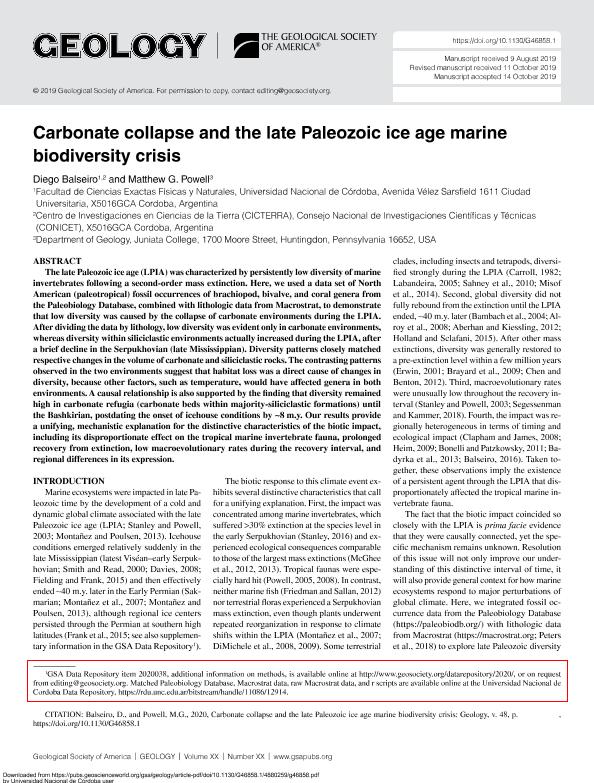Mostrar el registro sencillo del ítem
dc.contributor.author
Balseiro, Diego

dc.contributor.author
Powell, Matthew G.
dc.date.available
2021-11-01T18:45:34Z
dc.date.issued
2020-02
dc.identifier.citation
Balseiro, Diego; Powell, Matthew G.; Carbonate collapse and the late Paleozoic ice age marine biodiversity crisis; Geological Society of America; Geology; 48; 2; 2-2020; 118-122
dc.identifier.issn
0091-7613
dc.identifier.uri
http://hdl.handle.net/11336/145657
dc.description.abstract
The late Paleozoic ice age (LPIA) was characterized by persistently low diversity of marine invertebrates following a second-order mass extinction. Here, we used a data set of North American (paleotropical) fossil occurrences of brachiopod, bivalve, and coral genera from the Paleobiology Database, combined with lithologic data from Macrostrat, to demonstrate that low diversity was caused by the collapse of carbonate environments during the LPIA. After dividing the data by lithology, low diversity was evident only in carbonate environments, whereas diversity within siliciclastic environments actually increased during the LPIA, after a brief decline in the Serpukhovian (late Mississippian). Diversity patterns closely matched respective changes in the volume of carbonate and siliciclastic rocks. The contrasting patterns observed in the two environments suggest that habitat loss was a direct cause of changes in diversity, because other factors, such as temperature, would have affected genera in both environments. A causal relationship is also supported by the finding that diversity remained high in carbonate refugia (carbonate beds within majority-siliciclastic formations) until the Bashkirian, postdating the onset of icehouse conditions by ∼8 m.y. Our results provide a unifying, mechanistic explanation for the distinctive characteristics of the biotic impact, including its disproportionate effect on the tropical marine invertebrate fauna, prolonged recovery from extinction, low macroevolutionary rates during the recovery interval, and regional differences in its expression.
dc.format
application/pdf
dc.language.iso
eng
dc.publisher
Geological Society of America

dc.rights
info:eu-repo/semantics/openAccess
dc.rights.uri
https://creativecommons.org/licenses/by-nc-sa/2.5/ar/
dc.subject
Paleobiology Database
dc.subject
Macrostrat
dc.subject
carbonate
dc.subject
siliciclastic
dc.subject
diversity
dc.subject.classification
Paleontología

dc.subject.classification
Ciencias de la Tierra y relacionadas con el Medio Ambiente

dc.subject.classification
CIENCIAS NATURALES Y EXACTAS

dc.title
Carbonate collapse and the late Paleozoic ice age marine biodiversity crisis
dc.type
info:eu-repo/semantics/article
dc.type
info:ar-repo/semantics/artículo
dc.type
info:eu-repo/semantics/publishedVersion
dc.date.updated
2021-09-06T15:14:48Z
dc.journal.volume
48
dc.journal.number
2
dc.journal.pagination
118-122
dc.journal.pais
Estados Unidos

dc.journal.ciudad
Boulder
dc.description.fil
Fil: Balseiro, Diego. Consejo Nacional de Investigaciones Científicas y Técnicas. Centro Científico Tecnológico Conicet - Córdoba. Centro de Investigaciones en Ciencias de la Tierra. Universidad Nacional de Córdoba. Facultad de Ciencias Exactas Físicas y Naturales. Centro de Investigaciones en Ciencias de la Tierra; Argentina
dc.description.fil
Fil: Powell, Matthew G.. Juniata College; Estados Unidos
dc.journal.title
Geology

dc.relation.alternativeid
info:eu-repo/semantics/altIdentifier/url/https://pubs.geoscienceworld.org/gsa/geology/article-abstract/48/2/118/575927/Carbonate-collapse-and-the-late-Paleozoic-ice-age?redirectedFrom=fulltext
dc.relation.alternativeid
info:eu-repo/semantics/altIdentifier/doi/http://dx.doi.org/10.1130/G46858.1
Archivos asociados
